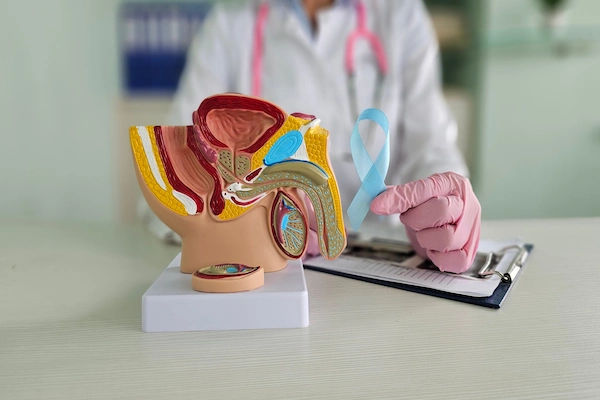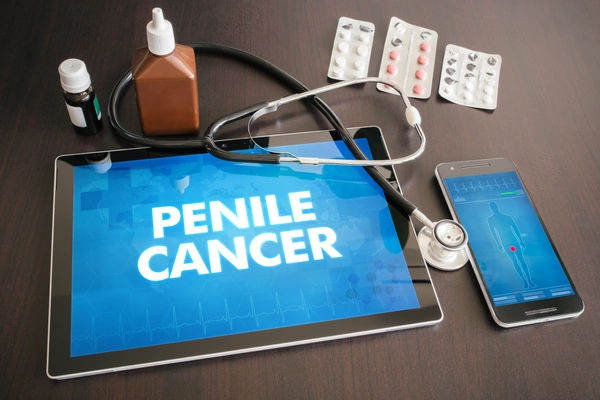What Leads To Signs Of Penile Cancer Signs And
Learn about penile cancer, including its early signs, potential causes, and when to seek medical attention for timely diagnosis and treatment.

Written by Dr. Dhankecha Mayank Dineshbhai
Reviewed by Dr. Vasanthasree Nair MBBS
Last updated on 6th Oct, 2025

Introduction
Penile cancer, while rare, is a serious health condition that affects men. The key to successful treatment and a positive outcome lies overwhelmingly in early detection. Recognising the early signs of penile cancer can feel daunting, and many men may feel embarrassed or hesitant to discuss changes in this intimate area. However, overcoming that hesitation is the most critical step you can take for your health. This article aims to demystify penile cancer by providing a clear, comprehensive guide to its signs and symptoms. We will walk you through what to look for, from subtle visual changes to more pronounced symptoms, explain the underlying causes and risk factors, and outline the simple steps for a self-examination. Our goal is to empower you with knowledge, so you can act promptly and confidently if you notice anything unusual. Remember, noticing a change is not a diagnosis, but it is a powerful reason to consult a healthcare professional without delay.
What is Penile Cancer? A Brief Overview
Penile cancer occurs when abnormal cells in the penis grow out of control. These cancerous cells most commonly originate in the skin cells on the glans (the head of the penis) or on the foreskin. The majority of penile cancers are a type called squamous cell carcinoma. Understanding that this is a manageable condition, especially when caught early, is the first step in reducing fear and promoting proactive health checks.
Why Early Recognition of Signs is Crucial?
The prognosis for penile cancer is exceptionally high when it is diagnosed at an early stage. Treatment can often be less invasive, focusing on removing the cancerous tissue while preserving as much of the penis as possible. This is crucial for maintaining urinary and sexual function. Delay, however, can allow the cancer to grow deeper into the penile tissue or spread to nearby lymph nodes and other parts of the body, making treatment more complex and reducing the chances of a full recovery. Therefore, knowing the early signs of penile cancer is not just about identification; it's about preserving your long-term health and quality of life.
Consult a Uro Oncologist for the best advice
The Most Common Signs and Symptoms of Penile Cancer
Being familiar with the symptoms can help you distinguish between a minor irritation and a potential warning sign. It's important to note that many symptoms can also be caused by non-cancerous conditions like infections or skin disorders. However, any persistent change warrants a professional evaluation.
Visual Changes: Lumps, Sores, and Growths
The most common early warning sign is a change in the skin of the penis. This can manifest in several ways:
- A lump or growth that may be flat or raised. It can be reddish, velvety, or brownish-blue.
- A sore or ulcer that does not heal over several weeks. This is one of the most critical signs to watch for.
- A wart-like growth that might be mistaken for a genital wart.
These growths are typically painless in the early stages, which can lead to the dangerous misconception that they are harmless.
Understanding Ulcers and Non-Healing Sores
A penile cancer sore that won't heal is a major red flag. Unlike a small cut or infection that resolves with time or basic hygiene, a cancerous ulcer will persist, may crust over, bleed occasionally, and slowly increase in size. If you have a sore that remains for more than two to four weeks, it is essential to have it examined by a doctor.
Changes in Skin Colour and Texture
You might notice areas of the penis skin becoming thicker or changing color. Patches of skin may become bluish-brown or develop a rash-like appearance. The texture might become scaly or develop a hardened, calloused feel. These changes often start on the glans or under the foreskin.
Unusual Discharge and Bleeding
A foul-smelling discharge can accumulate under the foreskin, which is often accompanied by irritation. You might also experience bleeding from the penis or from under the foreskin, which is not related to an injury. This bleeding can be a sign of an ulcer or growth breaking open.
Persistent Irritation, Smell, and Pain
As the condition progresses, symptoms can include persistent irritation, a constant foul smell despite washing, and eventually, pain in the penis itself. In advanced stages, you might feel a lump in the groin area, which could indicate that the cancer has spread to the lymph nodes.
What Leads to Penile Cancer? Understanding the Causes and Risk Factors
While the exact cause in every case isn't always clear, several strong risk factors have been identified. Understanding these can help in assessing your personal risk and taking preventive measures.
The Primary Cause: Human Papillomavirus (HPV)
Infection with certain high-risk strains of the Human Papillomavirus (HPV) is one of the most significant risk factors for penile cancer. HPV is a very common sexually transmitted infection. In most people, the immune system clears the virus, but in some cases, a persistent infection can lead to cellular changes that become cancerous over time.
The Role of Phimosis and Chronic Inflammation
Phimosis is a condition where the foreskin is too tight and cannot be pulled back over the glans. This can trap smegma (a natural secretion) and bacteria, leading to chronic inflammation and irritation. Long-term phimosis significantly increases the risk of developing penile cancer, as the constant irritation can trigger cellular changes.
Lifestyle and Hygiene Factors
Poor personal hygiene, especially in uncircumcised men, can lead to a buildup of smegma and bacteria, contributing to chronic inflammation. Smoking is another major risk factor, as chemicals from tobacco can damage the DNA in cells throughout the body, including those in the penis.
Age and Other Demographic Risks
Penile cancer is most commonly diagnosed in men over the age of 50. However, it can occur at any adult age. Geographically, it is more common in parts of Asia, Africa, and South America.
A Step-by-Step Guide to Self-Examination
Regular self-examination is a powerful tool for early detection. It’s quick, simple, and private. Perform this check monthly, ideally after a shower when the skin is relaxed.
1. Retract the Foreskin: If you are uncircumcised, gently pull back your foreskin completely.
2. Visual Inspection: Look carefully at the entire penis head, shaft, and foreskin under a good light. Check for any of the visual changes mentioned above: lumps, sores, colour changes, patches of thick skin, or warty growths.
3. Physical Feel: Feel the entire shaft for any lumps or thickening under the skin that you can't see.
4. Check the Tip: Gently press the tip of the penis to see if there is any discharge.
If you notice anything unusual during this how to check for penile cancer routine, do not panic. Simply make an appointment with a urologist or your primary care physician for a professional evaluation.
Diagnosis: What to Expect When You See a Doctor
If you visit a doctor with concerns about a potential sign of penile cancer, they will likely start with a physical examination. They may then recommend a biopsy to confirm whether cancer cells are present.
The Biopsy: Confirming a Diagnosis
A biopsy involves taking a small sample of tissue from the abnormal area and sending it to a lab for analysis. This is the only definitive way to diagnose penile cancer. If your condition does not improve after trying basic hygiene methods, consult a doctor online with Apollo24|7 for further evaluation and to discuss if a specialist referral is needed.
Staging the Cancer
If cancer is confirmed, further tests (like MRI, CT, or ultrasound scans) may be done to determine the "stage" of the
cancer, how deep it has grown and if it has spread. This information is crucial for planning the right treatment.
Treatment Options for Penile Cancer
Treatment depends entirely on the stage and location of the cancer. For very early-stage cancers, treatments can be minimally invasive, such as topical chemotherapy creams, laser therapy, or Mohs surgery. For more advanced cancers, surgery to remove the cancerous tissue (partial or total penectomy) may be necessary. Radiation therapy and chemotherapy are also options, particularly if the cancer has spread.
Prevention: Reducing Your Risk
While not all cases are preventable, you can significantly reduce your risk.
- HPV Vaccination: The HPV vaccine is highly effective in preventing infection from the high-risk HPV strains linked to penile cancer. It is recommended for both boys and girls.
- Good Hygiene: Regularly washing the penis, including gently pulling back the foreskin to clean beneath it, is essential for preventing the buildup of irritants.
- Safe Sex: Using condoms can reduce the risk of HPV and other STIs, though they do not offer complete protection as
HPV can infect areas not covered by a condom. - No Smoking: Quitting smoking eliminates a major risk factor for many cancers, including penile cancer.
Conclusion
Recognising the signs of penile cancer is an act of self-care and courage. While the topic may be uncomfortable, the knowledge empowers you to take control of your health. Remember, the symptoms described here are often caused by less serious conditions, but only a healthcare professional can provide an accurate diagnosis. Ignoring changes out of fear or embarrassment can have serious consequences. Your health is always the priority. If you have noticed any persistent changes, make an appointment with a urologist or talk to a doctor on a trusted platform like Apollo24|7. Taking that first step is the most powerful action you can take. By being informed and proactive, you are prioritising your well-being and ensuring the best possible outcome for any health concern.
Consult a Uro Oncologist for the best advice
Consult a Uro Oncologist for the best advice

Dr. Prashant Chandra Das
Surgical Oncologist
15 Years • MBBS (MKCG Medical college) MCh (Surgical Oncology, Kidwai memorial institute of Oncology, Bangalore) MS (General Surgery, BHU Varanasi) Fellowship in Minimal Access Surgery ( FMAS). ESSO Course On Minimally Invasive Esophagectomy & Gastrectomy (UMC, Utrecht, Netherlands). Trained in Robotic and Laparoscopic Cancer Surgery.
Bhubaneswar
Apollo Hospitals Old Sainik School Road, Bhubaneswar
(25+ Patients)

Dr. Dhruv B. Patel
Urologist
12 Years • MBBS, MS, DrNB (Urology - IKDRC, Ahmedabad)
Ahmedabad
Apollo Hospitals Gandhinagar, Ahmedabad
(25+ Patients)

Dr. Amit Choraria
Surgical Oncologist
18 Years • MBBS, MS (Surgery) Fellow, Surgical Oncology, Tata Medical Center (FSO) Fellow, European Board of Surgery (Surgical Oncology) (FEBS) Fellow, Minimal Access Surgery (FMAS) Fellow, Indian Association of Gastrointestinal Endosurgeons (FIAGES) UICC Fellow, Royal Marsden NHS, London, UK Visiting Scholar, Plastic Reconstructive Surgery, CGMH, Taiwan Fellow, Robotic Surgical Oncology, Vattikuti Foundation, USA
Kolkata
Apollo Multispeciality Hospitals , Kolkata, Kolkata

Dr. Manish C A
Uro Oncologist
7 Years • MBBS,MS General Surgery,M.Ch Urology,Post-Doctoral Fellowship in Uro-Oncology and Robotic Surgery.
Bengaluru
Apollo Hospitals Bannerghatta Road, Bengaluru

Dr. Vivek Venkatramani
Uro Oncologist
15 Years • M.Ch. (Urology) | M.S. (General Surgery) I Fellowship in Urologic Oncology (Miami, USA)
Mumbai
Apollo Hospitals CBD Belapur, Mumbai
Consult a Uro Oncologist for the best advice

Dr. Prashant Chandra Das
Surgical Oncologist
15 Years • MBBS (MKCG Medical college) MCh (Surgical Oncology, Kidwai memorial institute of Oncology, Bangalore) MS (General Surgery, BHU Varanasi) Fellowship in Minimal Access Surgery ( FMAS). ESSO Course On Minimally Invasive Esophagectomy & Gastrectomy (UMC, Utrecht, Netherlands). Trained in Robotic and Laparoscopic Cancer Surgery.
Bhubaneswar
Apollo Hospitals Old Sainik School Road, Bhubaneswar
(25+ Patients)

Dr. Dhruv B. Patel
Urologist
12 Years • MBBS, MS, DrNB (Urology - IKDRC, Ahmedabad)
Ahmedabad
Apollo Hospitals Gandhinagar, Ahmedabad
(25+ Patients)

Dr. Amit Choraria
Surgical Oncologist
18 Years • MBBS, MS (Surgery) Fellow, Surgical Oncology, Tata Medical Center (FSO) Fellow, European Board of Surgery (Surgical Oncology) (FEBS) Fellow, Minimal Access Surgery (FMAS) Fellow, Indian Association of Gastrointestinal Endosurgeons (FIAGES) UICC Fellow, Royal Marsden NHS, London, UK Visiting Scholar, Plastic Reconstructive Surgery, CGMH, Taiwan Fellow, Robotic Surgical Oncology, Vattikuti Foundation, USA
Kolkata
Apollo Multispeciality Hospitals , Kolkata, Kolkata

Dr. Manish C A
Uro Oncologist
7 Years • MBBS,MS General Surgery,M.Ch Urology,Post-Doctoral Fellowship in Uro-Oncology and Robotic Surgery.
Bengaluru
Apollo Hospitals Bannerghatta Road, Bengaluru

Dr. Vivek Venkatramani
Uro Oncologist
15 Years • M.Ch. (Urology) | M.S. (General Surgery) I Fellowship in Urologic Oncology (Miami, USA)
Mumbai
Apollo Hospitals CBD Belapur, Mumbai
More articles from Penile Cancer
Frequently Asked Questions
1. Is penile cancer curable?
Yes, penile cancer is highly curable, especially when diagnosed at an early stage. The five-year survival rate for localised penile cancer is over 80%. Early treatment is key to a full recovery.
2. What does a penile cancer lump feel like?
A penile cancer lump can vary. It may feel like a small, hard nodule or a larger, wart-like growth. It is often painless in the early stages. Any new, persistent lump on the penis should be evaluated by a doctor.
3. Can circumcision prevent penile cancer?
Studies show that circumcised men have a lower risk of developing penile cancer. This is largely because circumcision makes it easier to maintain good hygiene, preventing the buildup of smegma and chronic inflammation. However, it is not a complete guarantee, and good hygiene practices are effective for uncircumcised men as well.
4. How fast does penile cancer spread?
The growth rate can vary. Some types are slow-growing and may remain localised for a long time, while others can be more aggressive. This unpredictability is why prompt medical attention for any symptom is crucial to prevent the cancer from spreading to the lymph nodes.
5. Are all sores on the penis a sign of cancer?
No, many sores are caused by sexually transmitted infections (like herpes or syphilis), fungal infections, or simple irritation. The critical differentiator is persistence. A sore that does not heal within a few weeks is the main warning sign that requires a professional diagnosis.


